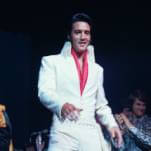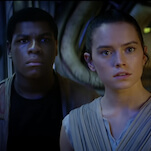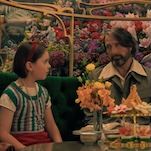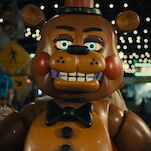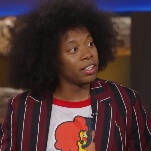There has been an enjoyable, welcome rise in girl-led animated kids shows over the past few years: Star Vs. The Forces Of Evil, She-Ra, Hilda, Amphibia, Home: Adventures With Tip & Oh, Harvey Girls Forever, Rapunzel’s Tangled Adventures, Hotel Transylvania: The Series, Lost In Oz, Costume Quest, to name a few. Some have been questionable (Star Vs. The Forces Of Evil’s final season has been quite… divisive), while others have been underrated gems (Hilda is an absolute delight). But the fact that there are now plentiful options signifies progress, with Netflix and Disney leading the way. The latter now is debuting The Owl House, from the mind of Dana Terrace, a former storyboard artist for Gravity Falls and Rapunzel’s Tangled Adventures and director for DuckTales. And while The Owl House is brimming with rich storytelling potential and imaginative creativity, the pilot, “A Lying Witch And A Warden,” feels undercooked and weirdly hesitant about what may unfold in the future.
Gravity Falls fans, of which there are many, will be pleased to hear that Alex Hirsch is lending his vocal talents, here to a character named King, an adorable wolf/dragon-like creature with illusions of grandeur and high stature. Wendie Malick plays the role of Eda, a grifter witch, slightly snarky but clearly quite confidently powerful; Malick provides a soft, sad edge to a majority of her line-readings suggesting something more tragic about the character than what she lets out on the surface. Leading the cast is Luz Noceda (voiced by Sarah Nicole Robles), a charming, “weird” teenage girl who prefers fantasy novels, fan-fiction, and anime over status quo, “average girl” hobbies and interests.
But about that: aren’t fantasy novels and anime pretty much status quo these days? The narrative lessons about atypical characters embracing their weirdness and quirks, their “nontraditional” preference for all things abnormal and off-kilter, particularly among girls, is very important, but in 2020 it feels less dire and meaningful. There’s some specificity to Luz’s behavior that causes concerns; letting loose snakes or spiders all over the school in a bid for a book report is concerning. But would flipping one’s eyelids cause entire gym to freak out? I feel like every class had at least one kid that could do that. There’s a difference between the broad acceptance of unconventional proclivities and causing a mass panic; The Owl House muddles that distinction. Luz is a fun, charismatic, adventurous sort, although she seems to lack that clear sense of specificity or depth–but of course that can be clarified in a few episodes. Thematically, I’m reminded of Netflix’s Twelve Forever, another girl-led show about overactive, imaginative young women pressured to drop all those silly ideas and be “normal.” Twelve Forever has its issues, both on the show and off it, but there’s at least a sense of its Midwest, small town setting as the backdrop of conformist pressure. Not much is revealed here that pushes down on Luz except the typical tsk-tsking of parents and adult figures, but you can’t help but believe at some level it’s warranted.
But chasing an errant owl that snatches up Luz’s YA fantasy book has her stumbling into the magical, mythical world of the Boiling Isles (a peculiar name that hints at something heated and dangerous beneath the surface), and the show comes alive–at first. It’s a world full of vibrant backdrops and marvelous creatures, with monsters-as-normal-people scattered about. Here, Luz meets Eda, hawking the stolen human wares as specialized, rare goods, and her wondrous feats of magic entices the young girl, even as she realizes the witch is the most wanted person in the land. Luz escapes with her back to their home, where she then meets King, and crushes on him like a plush doll. The setting, and set-up, maintains a fun vibe if not particularly novel, but as Luz, Eda, and King start to interact, their unique and strong rapport becomes more evident, even though there’s a hint of peril here, since neither Eda nor King are in any position to teach or care for Luz. (Eda mostly wants to use Luz for her human knowledge and stuff, so Luz isn’t exactly safe, especially with her mind all caught up in the fantastical elements.) But still, you can tell this is a strong, strong group of weirdos, bonded together by a sense of isolation and longing–even if some of it in their heads.
Because the truth is, it isn’t exactly clear what makes Luz, Eda, and King so particularly weird that they are the targets of The Warden, a beast of a character wearing a plague-doctor mask with some particular odd powers of his own. His prison is filled with characters who express their own unique habits at their own peril (a creature that loves to eat his own eyes; a tiny, bratty socialist creature with a oversized nose; an older girl who also, coincidently, loves writing fan-fiction) but it isn’t evident what makes their specific quirks crimes, but other monsters safe from persecution. The Owl House may be building up to that–how what is deemed “normal” by society is arbitrary and enforced by the whims of those with power and influence (especially in regards to our socialist friend)–but it’s hard to make that claim in the pilot. In fact, its third act is kind of baffling, when the Warden, after having finally Eda in his clutches, shifts suddenly to admitting to having a creepy, overzealous crush on her. It’s not as amusing as I think the creators may think it is, mainly because it feels like a fakeout, as if there ought to be a deeper purpose for the Warden’s overall behavior than some deeply uncomfortable obsession with Eda. After all, this creature has every “weirdo” jailed up and a vault of every “unique” item he could steal. The Warden ought to be motivated by something other than a perverse desire for one person. What else makes him tick?
But of course, shows like this often bask and revel in inscrutability, keeping its bigger questions and revelations about its characters and its setting in the shadows until it’s time to best expose them (the very last shot, in which the window of the house actually blinks, may have you rubbing your chin). But there’s an equally acceptable chance that The Owl House is comfortable letting its weird inscrutability be the very point. After all, the show wants its characters and viewers to embrace their own layers of unique oddities and preferences, and thrive within them. Luz finds her calling, learning how to be a witch, among these two potential friends, and even if that journey is fraught with danger, uncertainty, and rules beyond all comprehension, she is determined to answer that call, consequences be damned. The fact that Luz, at the end, lies to her mom about being in normal camp is telling; being truly yourself is freeing, but at what cost?
Stray observations
- I hope we get more of Luz’ home life. I think a more detailed look at what she has to live through will give provide a better sense of what being “normal” means and what her forays into fantasy and silliness means to her.
- What was it about the force field that only humans could pass through? The Warden himself pulls his mask off and reveals to be a terrifying mouth monster, but does that means he can’t pass through it either? Obviously he probably can turn it off and on, but it seems such a particularly arbitrary thing that it can’t be a coincidence. Right?
- Hirsch as King is a delight, although at times he has Bill Cipher’s cadence a bit and his quips aren’t quite as funny as you’d like. That’ll should get better with time.
- We won’t be doing regular coverage, but will drop in as the season warrants.


































